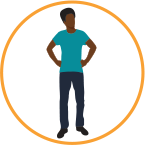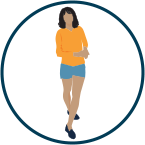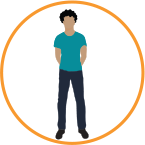WHO ARE CHWs (COMMUNITY HEALTH WORKERS)?
Community Health Workers promote healthy behaviors and improve overall quality of life – with compassion for the communities we serve.
“A Community Health Worker is a frontline public health worker who is a trusted member of and/or has an unusually close understanding of the community served. This trusting relationship enables the worker to serve as a liaison/link/intermediary between health/social services and the community to facilitate access to services and improve the quality and cultural competence of service delivery. A community health worker also builds individual and community capacity by increasing health knowledge and self-sufficiency through a range of activities such as outreach, community education, informal counseling, social support, and advocacy.”
–The American Public Health Association
“Community Health Worker” is an Umbrella Term that Encompasses Many Job Titles:
| Case Worker/Manager | Community Health Advocate | Community Health Outreach Worker |
| Community Health Worker | Community Outreach Worker | Community Liaison |
| Community Health Representative | Enrollment Specialist | Health Ambassador |
| Health Educator | Patient Navigator | Peer Educator |
Supporting Individuals
The CHW’s ability to bring the patients’ perspective to the table can provide the treatment team with inside information that can positively impact the patient’s outcomes. This is accomplished through the unique role a CHW has as the bridge between the patient in the community and the providers and services they need to access. CHWs are trained to meet patients in their own environment, “where they are”. By building a strong and trusting CHW/patient relationship the CHW can “peel back the layers of the onion” and reveal the patient’s underlying Social Drivers of Health (SDOH) needs, many of which may be barriers to achieving better health. The successful process of integrating CHWs into a patient’s care team has been well documented and defined.
Supporting Providers
Healthcare providers often spend their days working within fairly narrow constraints. X number of patients to see per day, meaning X number of minutes with each patient. It’s nearly impossible for providers to be given the flexibility and enough time to identify all the barriers for each patient that exist outside of the exam room. Studies indicate that medical care only accounts for around 20 percent of the variation in health outcomes, whereas 80 percent can be traced back to the SDOH.
For individual patients, social needs such as food or housing insecurity, can have a substantial negative effect on their health. As determining factors of population health are intricately interwoven, one can’t expect to enhance population health outcomes by solely investing in medical care.
CHWs Help Providers in a Number of Ways
CHWs HELP PROVIDERS AND SOCIAL SERVICE AGENCIES ANSWER THESE QUESTIONS
- Does my patient have all the resources they need to lead a healthy life?
- Is there something else I can do to help my patient be successful with their care plan?
- Does my patient take their medications as prescribed?
- Did my patient really understand the treatment plan I gave them when they left my office?
- Why do they miss so many appointments?
- How confident am I that my patient will be successful with the treatment plan?
- What kind of support does my patient have at home?
- Is my patient safe in their home?
CHWs CAN HELP BY…
- Participating in discharge planning
- Providing on-going support after hospitalization
- Helping patients organize their day, integrating treatment and discharge instructions
- Maximizing engagement
- Improving patients’ awareness of factors that influence their health
- Providing education and support to improve patient’s ability to manage their health
- Helping patients to better understand provider instructions and medications
- Communicating with providers concerning changes in health status
- Helping patient manage chronic disease to reduce ED utilization or re-hospitalization
- Being the eyes and ears for the provider

Providers are often aware of SDOH barriers that exist, but are limited in what they can do to address them. Without CHWs on the medical team, providers will often ask the nursing staff to investigate these barriers and address what seems most important, often setting up transportation or filling out medical forms. CHWs have the ability to identify those barriers outside of the exam room and take the time to help patients overcome them. They can work with the patients to not only overcome these barriers, but to learn the skills needed to gain independence in these areas and be able to accomplish the once hard tasks on their own. This allows the providers and nursing staff to focus on the medical care and work to the highest of their professional licenses.

CHWs provide additional eyes and ears that can listen to and see the patient in their own environment. Providers can only work with the information the patient presents them with and what they can see in front of them. Patients will often share information with CHWs, as trusted community members, that they don’t share with a provider. CHWs also have the ability to spend time with the patients outside of the medical office, seeing what their living environment is like, and learning the external factors that affect the individual. This extra information that the CHW can provide often can make differences in how providers treat their patient’s medical conditions. Understanding that the patient may live somewhere with mold or can only cook with a microwave can change how they treat their asthma or talk about nutrition with them.

As healthcare moves away from a fee for service model and looks more closely at quality payments, CHWs are a vital part of that transition. CHWs can work with providers to ensure patients are not falling through the cracks, are understanding and following through on treatment plans, and have the knowledge and confidence in managing their health conditions to help avoid unnecessary emergency room visits.
CHWs can serve in variety of settings and organizations, not just primary healthcare. As with many healthcare professions, CHWs can specialize in assisting different populations such as older adults, people with substance use disorders, school age children, pregnant mothers, refugee, immigrant and migrant communities or people with chronic diseases.
Policymakers, public health program administrators, social service providers, and health care employers should recognize CHWs as an essential piece of the health care system. Community health workers educate and empower clients and communities to take their health and wellbeing into their own hands. CHWs also facilitate access to health and social services outside clinics and hospitals, which can dramatically improve the health of vulnerable populations.
Supporting Community
CHWs improve individual and community health with their deep understanding of their communities and their own lived experience.
CHWs may assist one person at a time, helping them to regain their health, reducing the social barriers in their lives, and connecting them to support and resources. For every person that becomes healthier, there is a family that becomes healthier, and this ripples out to improve the overall health of the community.
CHWs excel in community outreach, which is often essential to promote engagement of individuals in preventative screenings, disease related education or success in working with a population with specific needs such as English as a second language or undeserved communities. Most recently, CHWs have been seen nationally as a resource in providing COVID-19 safety and vaccine education, increasing access to vaccines and tests for undeserved populations, and for being able to test identify the most vulnerable populations in their communities and advocating for their specific needs.